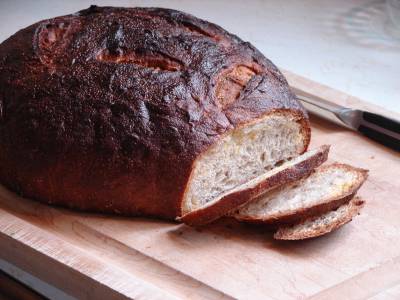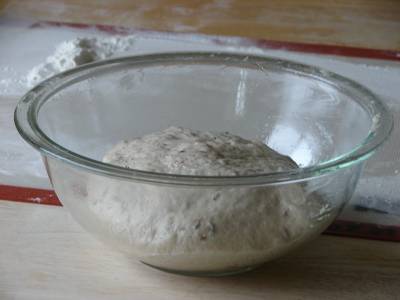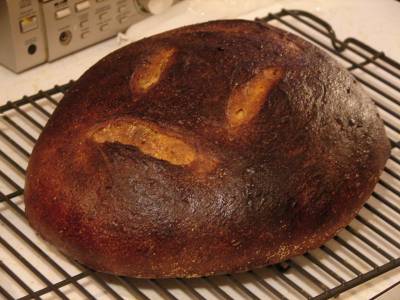This hearty rye bread is an adaptation on Rose Levy Beranbaum’s bread from her book “The Bread Bible.” While this bread does take careful  planning and execution, it doesn’t have too many steps and with a little planning, this bread is quite manageable to make. Overall it will rise about 4 hours, however you can make the sponge the day before and let it sit in the fridge overnight. That way, you only have two rising times in the baking bowl and one rising time on the baking sheet. planning and execution, it doesn’t have too many steps and with a little planning, this bread is quite manageable to make. Overall it will rise about 4 hours, however you can make the sponge the day before and let it sit in the fridge overnight. That way, you only have two rising times in the baking bowl and one rising time on the baking sheet.
Because this bread, even though slightly laborious, turned out lovely. It has a real, nice rye flavor coupled with the caraway seeds. As we served this bread, the comments were – “This taste like a REAL Jewish Rye Bread” and “This is just like a bread from a deli.” Sponge
¾ cup bread flour
¾ cup rye flour
½ teaspoon instant yeast
2 tablespoons sugar
1 ½ cup water, room temperature
Flour Mixture
2 ¼ cups bread flour
½ plus 1/8 teaspoon instant yeast
2 tablespoons caraway seeds
½ tablespoon salt
½ tablespoon vegetable oil
2 teaspoons cornmeal Method: Make the sponge by mixing bread flour, rye flour, yeast, sugar and water in a large bowl until smooth, about 2 minutes. Set it aside and cover it with plastic wrap.
Make the flour mixture by mixing the bread flour (reserve ¼ cup), yeast, caraway seeds and salt. Gently place the flour mixture on top of the sponge, cover with plastic wrap and allow it to ferment 1 to 4 hours (you can place it in the fridge after one hour and leave it overnight if it’s more convenient).
To mix the dough by hand, add the oil and stir the dough together. Knead the dough together in the bowl until it comes together, then knead it on a floured surface for 5 minutes to develop the gluten structure. Cover it with an inverted bowl and let rest for 20 minutes. Knead the dough for another 5 to 10 minutes until it’s very smooth. Add some additional flour if the dough is sticky.
You can also do this step using a machine. Then, using a dough hook, mix the mixture (and add the remaining ¼ cup of flour), on low for about 1 minute, then increase the speed to medium and mix for 10 minutes. Knead in some flour on the counter if the dough is too sticky.
Now, place the dough in a lightly greased 2-quart bowl (or dough rising container). Cover with plastic wrap and let rise until doubled, 1 ½ to 2 hours, ideally in 75 – 80 degrees. (If your kitchen is colder than that, you can put your oven on warm for a minute, then shut it off and leave the dough inside the oven for the rising period).
Once it’s doubled, scrape it out on a floured surface, give it a business letter turn (stretch the dough out and fold it on top of it a couple of times). Place it in the oiled bowl again, cover with plastic wrap and allow to rest a second time until it’s doubled, about 45 minutes.
Now, turn the dough on a lightly floured surface, press it down to flatten it slightly. Round the dough into a ball about 5 ½ inches by 2 ½ inches high (you might need to press out quite a bit of air in order to make such a small ball). Set it on a cornmeal sprinkled baking sheet, cover it with oiled plastic wrap and allow to rise until almost doubled, about 1 hour to 1 hour and 15 minutes.
Preheat the oven to 450 degrees (it is recommended that you pre-heat the oven an hour before baking). On the lowest shelf in the oven, place a cast-iron pan or a sheet pan. Above, place a baking stone or a sheet pan.
Now slash the bread a couple of times, mist it with water and quickly set the baking sheet on the hot stone. Toss ½ cup of ice cubes into the pan beneath and shut the door immediately.  Bake for 15 minutes, then lower the temperature to 400 degrees and continue baking for 30 to 40 minutes until the bread is golden brown and an instant-read thermometer inserted into the center will read about 190 degrees. Halfway through baking, lift the bread from the pan and set it directly on the baking stone, also turn it around for even baking. Let cool on a wire rack. Bake for 15 minutes, then lower the temperature to 400 degrees and continue baking for 30 to 40 minutes until the bread is golden brown and an instant-read thermometer inserted into the center will read about 190 degrees. Halfway through baking, lift the bread from the pan and set it directly on the baking stone, also turn it around for even baking. Let cool on a wire rack.
|

